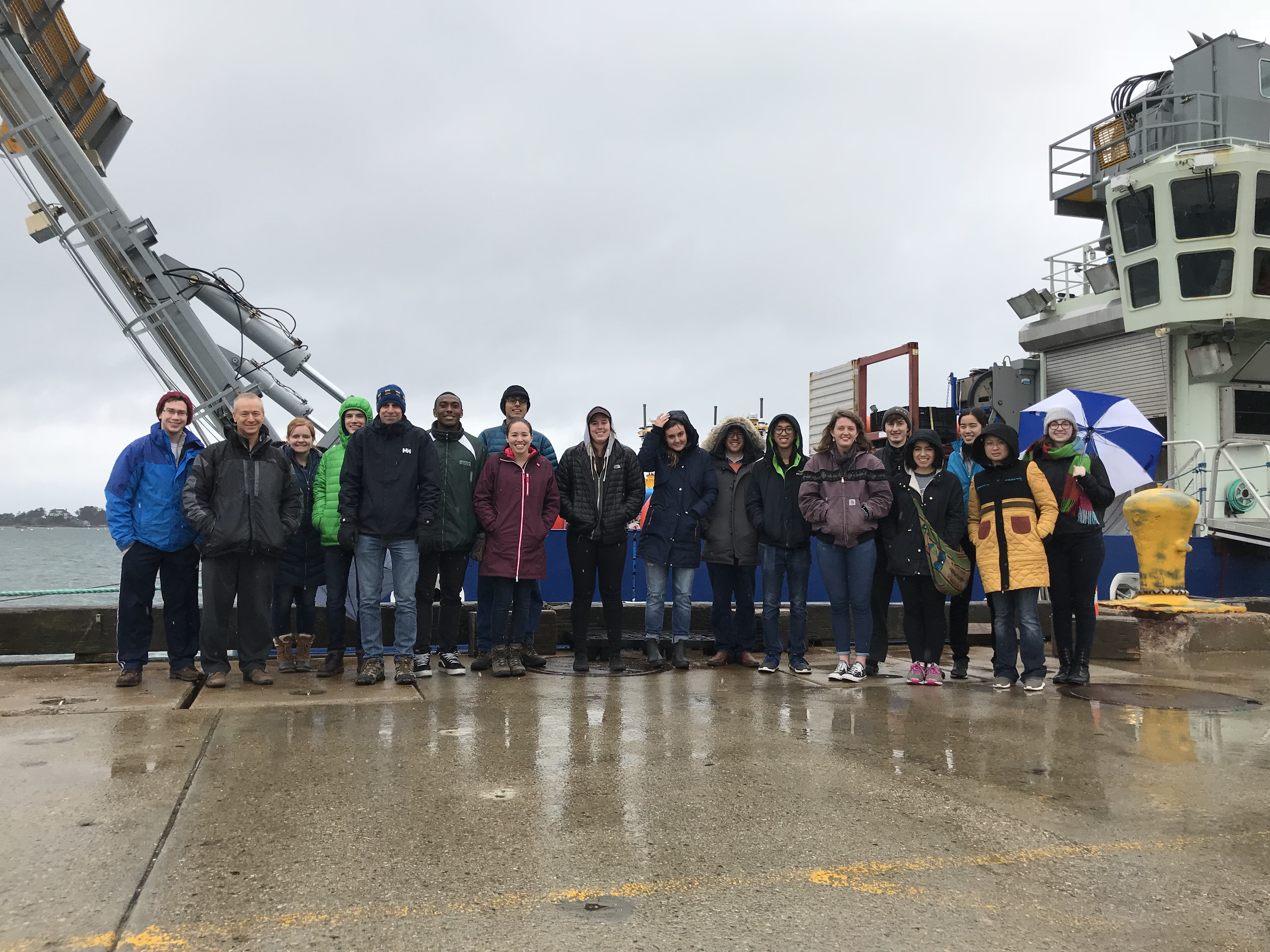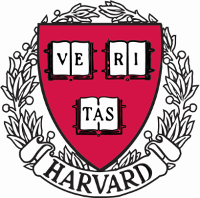
Field trip to the Woods Hole Oceanographic Institution, spring 2018.
-
Instructor:
- Eli Tziperman, office hours: please see FAS course web page.
-
TF:
- Wanying Kang, wanyingkang@g.harvard.edu. Office Hours: see FAS course web page.
-
Day, time:
- Tuesday, Thursday, 1:00-2:30.
-
Location:
- University Museum, 24 Oxford St, third floor, room 375
-
Field Trip!
- To the Woods Hole Oceanographic Institution/ WHOI, obligatory & fun;
hosted by Dr. Bob Pickart; Friday April 6, 2018. Departing 7am, returning around
6pm.
-
Matlab
- will be used for HW and class demonstrations. If you would like a refresher, consider
the Matlab boot camp, 3-4 lectures during the beginning of the term. Register here.
-
Section:
- time and location: see FAS course web page.
-
Source materials:
- Here. To access from outside campus or from the Harvard wireless
network, use the VPN software available from the FAS software download site.
-
Important past events…:
-
- WHOI field trip. In previous trips we visited the R/V Atlantis, R/V Knorr, R/V
Armstrong, the submersible Alvin, and we toured WHOI labs. Photos: 2005, 2008,
2010, 2012, 2014, 2016, 2018.
- EPS 131 Oscars (video project) events: 2005: surface waves; 2008: internal waves;
2010: great Pacific garbage patch; 2012: thermohaline circulation; 2014: surface
waves; 2016: brine rejection; 2018: phase speed in 2d;
- zeta vs xi (ζ vs ξ) competition: 2008, 2010, 2012, 2014, 2016, 2018.
-
Requirements:
- Homework will be assigned every 9-10 days (40% of course grade). Each student
will give a short (10 min) presentation (details), which, together with a small-group video
project (examples above) and/ or a wikipedia entry-writing project, will constitute another
30%. The final exam will be a take-home (30%).
Collaboration policy: we strongly encourage you to discuss and work on homework
problems with other students and with the teaching staff. However, after discussions
with peers, you need to work through the problems yourself and ensure that any
answers you submit for evaluation are the result of your own efforts, reflect your
own understanding and are written in your own words. You must appropriately
cite any books, articles, websites, lectures, etc that have helped you with your
work.
Course materials are the property of the instructional staff, or other copyright holders, and
are provided for your personal use. You may not distribute them or post them on websites
without permission of the course instructor.
Announcements
Last updated: May 11, 2018
Feel free to write or call with any questions:
Eli Tziperman; eli@eps.harvard.edu
Office hours: see course web page.
Contents
1 Textbooks
Main ones, although it wont be followed very closely:
- (Kn) J. A. Knauss, introduction to physical oceanography, 2nd edition, 1996, Prentice
Hall, Upper Saddle River, New Jersey.
Also useful: see additional readings below.
2 Outline
Observations and understanding of ocean physics, from local beach waves to the effects of the
oceans on global climate. Topics covered include wave motions such as ocean surface waves,
internal waves, tsunamis and tides; currents, including the wind driven circulation, and the Gulf
stream; coastal upwelling and fisheries; temperature, salinity, the overturning thermohaline
circulation and its effect on global climate stability and variability; the basic fluid dynamics
equations will be gradually introduced; El Niņo evens in the equatorial Pacific Ocean; the
greenhouse effect, oceans and global warming; ocean observations by ships, satellites, moorings,
floats and more.
A field trip to the Woods Hole Oceanographic Institution on Cape Cod will be held during the
course, which will be an opportunity to learn about sea-going oceanography.
Prerequisite: Applied Mathematics 21a,b; Physical Sciences 12a,b, Physics 15a,b,c or Applied
Physics 50a,b; or equivalents/ permission of instructor.
The students will be introduced to the Matlab software for scientific computation and graphics,
which will be used for some of the homework assignments.
3 Syllabus
Detailed lecture notes, directory with all source materials for the lectures.
- Outline and motivation
- Temperature and salinity
downloads;
- Horizontal circulation I: currents, Coriolis force
downloads;
- Waves and oscillations I: basics
downloads;
- Sea-going physical oceanography
Finally, the real stuff. Two lectures by Dr. Bob Pickart from the Woods Hole
Oceanographic Institution, and a field trip to Woods Hole.
- Friction, Ekman moving icebergs and feeding the fish
downloads;
- The thermohaline circulation
downloads;
- Horizontal circulation II: Gulf Stream and other western boundary currents,
vorticity, Rossby waves
downloads;
- El Nino
downloads;
- Time permitting:
- Abrupt climate change
downloads;
- Some fluid dynamics fundamentals
downloads;
- Waves and oscillations II: deep ocean surface waves
downloads;
4 Additional readings
Beginning texts:
- John A. Knauss, Introduction to Physical Oceanography, 320 pages; 2nd edition, 2005.
- J. Marshall and R. A. Plumb, Atmosphere, ocean, and climate dynamics, Elsevier
Academic Press, Burlington, MA, USA, 2008, 319pp.
- Lynne D. Talley, George L. Pickard, William J. Emery and James H. Swift, Descriptive
Physical Oceanography - An Introduction, 2011 (sixth edition) available on-line at
http://www.sciencedirect.com/science/book/9780750645522
- Stephen Pond and George L. Pickard, Introductory dynamical Oceanography, 3rd
edition, Butterworth-Heinemann, 1993.
- Open university: Ocean Circulation (Second Edition); Evelyn Brown, Angela Colling,
Dave Park, John Phillips, Dave Rothery and John Wright
- Open university: Waves, Tides and Shallow-Water Processes, Second Edition;
- (St) Robert H. Stewart, on-line physical oceanography book
- On-line version of ’Regional oceanography’
Intermediate texts:
- Philander, S. G. H., El Nino, La Nina, and the Southern Oscillation., Academic Press,
1990,
- (Ku) Kundo P.K. and Cohen I.M., Fluid mechanics. 2nd edition 2002.
- Benoit Cushman-Roisin, Introduction to geophysical fluid dynamics, Prentice-Hall,
1995,
Advanced texts:
- Vallis, G., 2005, Atmospheric and oceanic fluid dynamics, fundamentals and large-scale
circulation, Cambridge University Press.
- Pedlosky, J., 1987, Geophysical Fluid Dynamics., 2nd edition, Springer-Verlag.
- Pedlosky, J., 1996, ocean circulation theory, Springer-Verlag, Berlin-Heidelberg-New
York.
- Pedlosky, J., 2003, waves in the ocean and atmosphere., Springer-Verlag,
Berlin-Heidelberg-New York.
- Gill, A. E, 1982, Atmosphere–ocean dynamics, Academic Press, London
5 Links


